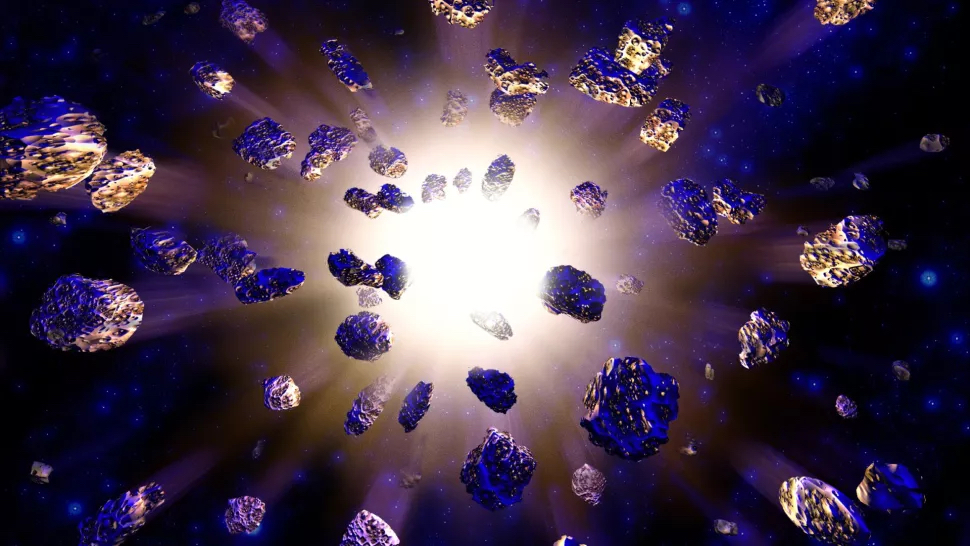How long can an asteroid 'survive'?
Asteroids are left over from the early solar system. Here's how they get destroyed.

In October 2020, NASA's OSIRIS-REx spacecraft approached the asteroid Bennu. The probe, which had been orbiting its target for nearly two years, lowered a robotic arm and scooped up about 4.4 pounds (2 kilograms) of dusty, rocky material from the asteroid's surface. This material is the first sample of an asteroid collected by a U.S. mission, and it might help scientists answer some puzzling questions: How old are asteroids like Bennu? And how long do they last?
To understand how long asteroids last, it's crucial to know when and how they formed. The asteroids in our solar system coalesced out of the protoplanetary disk, a thick collection of dust and rocky material that swirled around our sun 4.5 billion years ago.
"The dust began to coagulate," said Harold Connolly, an astronomer at Rowan University in New Jersey and a mission sample scientist for OSIRIS-REx. Over time, these dust bunnies collected more and more material, collided with one another and stuck together. Some of them snowballed into whole planets, like Earth. Others became moons, comets and asteroids.
Most of the asteroids in the solar system now reside in the asteroid belt, which stretches between Mars and Jupiter, though occasionally some get ejected from the belt and become near-Earth asteroids. The largest intact asteroids are roughly the same age as the solar system: 4.5 billion years old. But some asteroids can be considered younger, since they consist of smaller pieces that broke off from these larger bodies.
How do asteroids die?
Asteroids can break up and eventually get destroyed in a few different ways. One is by spinning. Asteroids are usually irregularly shaped — unlike planets, which have enough gravity to pull themselves into a rough sphere — and so they tend to list to one side. If they start to spin after a collision or from being pushed by solar radiation, the force can send chunks of asteroid flying off into space. "You get a little difference in torque here and there, and eventually it falls apart," Connolly said.
Asteroids can also fragment from thermal stress, which is caused when their materials expand and contract in the sun's heat for millions of years, or when they experience sudden water loss as ice inside the asteroid is converted into gas by our star's warmth.
Get the Space.com Newsletter
Breaking space news, the latest updates on rocket launches, skywatching events and more!
Sometimes, asteroids break up from collisions with other rocky celestial objects, "kind of like a cosmic billiards game," Connolly told Live Science. Based on the probability of breakup, "a 1 kilometer [0.6 mile] thing can survive about 440 million years, [and] a 10 kilometer [6.2 miles] object around 4 billion years" in the asteroid belt, Kevin Walsh, an astronomer at the Southwest Research Institute in Colorado, told Live Science in an email.
Related: What happened when the dinosaur-killing asteroid slammed into Earth?
Scientists are still working to determine how long the largest asteroids can last, but it's possible that some may endure as long as the rocky inner planets of the solar system do — between 8 billion and 10 billion years. (In approximately 5 billion years, when the sun is around 10 billion years old, our star is expected to burn out and swallow up its neighbors, including planets and asteroids.)
Once an asteroid fragments into small enough pieces, its tiny bits no longer count as an asteroid — a chunk of space debris smaller than 3.2 feet (1 meter) is technically reclassified as a meteoroid, according to NASA. At this point, those meteoroid fragments may collide with a larger body, leaving an impact crater. Or they may cross paths with a planet that has an atmosphere, such as Earth, and become meteors streaking across the sky.
The pieces may also come back together and form what's known as a rubble pile asteroid. These composite bodies get "a second life, in a smaller fragmented version of the initial asteroid," Fred Jourdan, a geochronologist at Curtin University in Australia, told Live Science.
The various bits and pieces are held together with nothing more than their own gravity acting as glue. "It is literally a big pile of rocks with a lot of empty space," Walsh said.
That may seem like a tenuous connection, but these asteroids are tougher than they sound: The space between their pieces acts like shock absorbers against collisions. "Their particular structure makes them almost indestructible," Jourdan said, unless they crash into a planet or fall into the sun. Most near-Earth asteroids, including Bennu, are rubble pile asteroids.
When the samples from Bennu reach Earth this fall, their structure will give astronomers an even better idea of when the rubble pile's components broke off from their parent bodies and how they came back together. "It's going to be a lot of fun," Connolly said.
Join our Space Forums to keep talking space on the latest missions, night sky and more! And if you have a news tip, correction or comment, let us know at: community@space.com.

Joanna Thompson is a science journalist and runner based in New York. She holds a B.S. in Zoology and a B.A. in Creative Writing from North Carolina State University, as well as a Master's in Science Journalism from NYU's Science, Health and Environmental Reporting Program. Find more of her work in Scientific American, The Daily Beast, Atlas Obscura or Audubon Magazine.
-
rod I read this report originally on livescience.com, sister site of space.com.Reply
My note. Asteroids that are NEO-NEAs do not last this long (440 Myr), various reports indicate perhaps 10 Myr time spans, that includes Centaurs much farther out in the solar system. However, this provides a number in the article. Min lifetime 440E+6 years, max lifetime 4E+9 years, some large asteroid lifetimes are not known so perhaps 10 Gyr is used for their max lifetimes in the solar system.
Some summary thoughts here. This brief report suggests some asteroids can last 440E+6 years, some 4E+9 years, and some large asteroids perhaps 1E+10 years in the solar system. Asteroids also have cosmic ray exposure ages for pieces returned to Earth as well as radiometric ages. This is true of meteorites too. A complete list of these different ages obtained and shown I do not see in a database for example showing all. Many asteroids said to have at least a 4 Gyr lifetime, would need to complete perhaps 1E+9 orbits around the Sun or more. -
rod "Jopek et al. (1995) integrated the orbits of 17 bolides for 1 Myr in the past. They found that half of the studied cases belonged to the ‘fast-track’ category – in the terminology coined by Froeschle et al. (1995) – in or near a secular resonance or an MMR with Jupiter, and the rest were ‘slow-track’ objects. The estimated dynamical lifetime of the asteroids was found to be less that 1 Myr.", ref - Resonant mechanisms that produce near-Sun asteroids, https://arxiv.org/abs/2304.00561, 02-April-2023. "All near-Earth asteroids (NEAs) that reach sufficiently small perihelion distances will undergo a so-called super-catastrophic disruption. The mechanisms causing such disruptions are currently unknown or, at least, undetermined."Reply
Modeling various asteroid lifetimes in our solar system can be fun :)
"One of the primary goals of this study is to compute 𝜏lq, the effective dynamical small-𝑞 lifetimes of NEAs (𝑞
∗ < 𝑞 < 𝑞𝑙), classified according to the resonances they are trapped in. Gladman et al. (1997, 2000); Foschini et al. (2000) suggest that the typical dynamical lifetimes of NEAs are ∼ 10^7 yr. In particular, Gladman et al. (1997) calculated the time-scales of the half-life decay of active particles according to each resonance, and found it to be between 2-2.5 Myr for 𝜈6 and 3:1J MMR, ∼ 0.5 Myr for 5:2J and much longer for the rest 8:3J, 7:3J, 9:4J and 2:1J MMRs. Farinella et al. (1994) found that, in general, near-Sun NEAs trapped in resonances have lifetime of the order of 10^6 yr, while 3:1J MMR may drastically raise the eccentricity of an NEA in < 10^5 yr. Jopek et al. (1995) suggest that the objects they studied collided with the Sun within a few 10^5 yr,
while Foschini et al. (2000) argue that the recorded dynamical life times range from 10^5 yr to as long as > 10^7 yr."
Perhaps someday, a complete list of various dynamic ages calculated, radiometric ages reported, and younger cosmic ray exposure ages will be presented like I see for the exoplanet sites.










